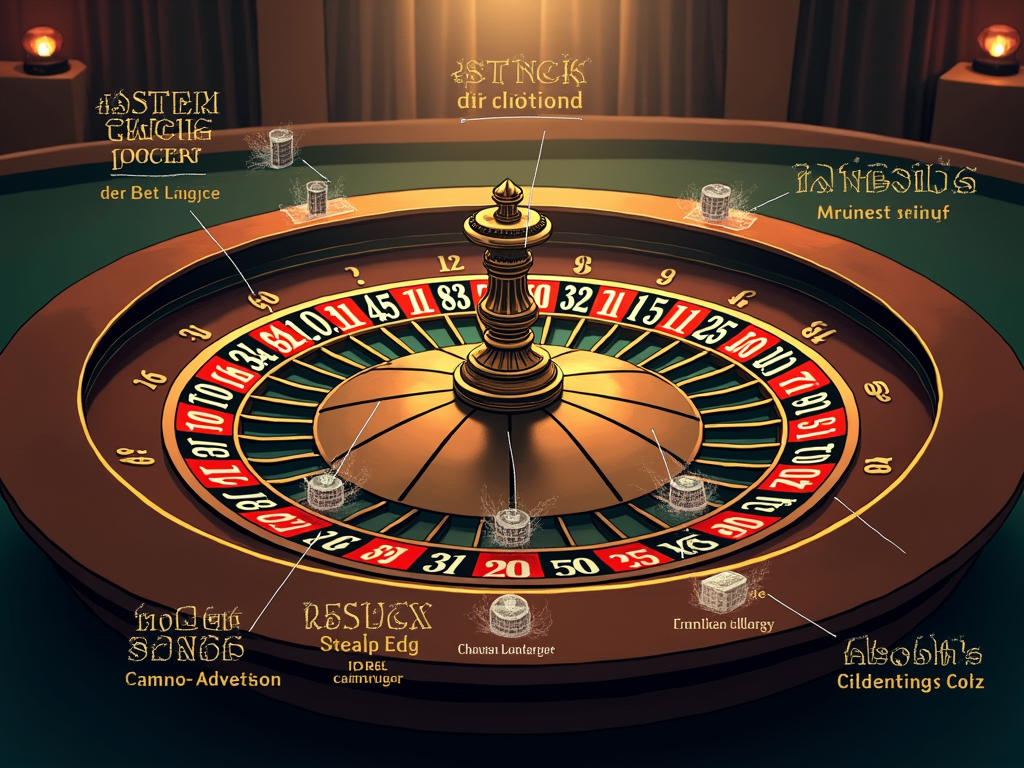Roulette Betting Strategies and Their Limits
Roulette betting strategies remain compelling to casino players searching for a winning edge, though the fundamental house advantage makes consistent profits impossible. The casino’s built-in edge of 2.70% in European roulette and 5.26% in American roulette stems from the green zero pockets — a mathematical reality no betting pattern can beat.
Key Takeaways
- Each roulette spin creates a fresh, random outcome unaffected by past results
- The Martingale system’s doubles-after-loss approach leads to exponential bet sizes that drain bankrolls and hit table maximums
- The Fibonacci system uses a gentler progression but still fails against the casino’s mathematical edge
- Alternative methods like D’Alembert and James Bond provide betting structure while facing identical statistical barriers
- Smart bankroll control and strict loss limits matter more than any specific betting pattern
I focus on the cold hard facts — popular betting systems might add excitement and structure to roulette sessions, but they can’t alter the game’s fixed odds. The independent nature of each spin means past results hold no predictive power for future outcomes. My experience shows systematic approaches often accelerate losses rather than create wins.
The Most Effective Approach
The most effective approach combines entertainment value with strict financial discipline. Setting clear loss limits and maintaining bet sizes within comfortable ranges leads to better outcomes than chasing losses through escalating bet progressions.
Why Most Roulette Betting Systems Fail in the Long Run
I’ve seen countless players walk up to roulette tables with betting systems they’re sure will beat the odds. Let me explain why these systems don’t work as planned – it all comes down to simple math and probability.
The Unbeatable House Edge
No matter how creative your betting pattern might be, you can’t escape the built-in casino advantage. On a European roulette table with standard rules, the house edge sits firmly at 2.70%, while American roulette carries a steeper 5.26% edge. These percentages don’t budge, regardless of your betting system.
The presence of the green zero pocket (and double zero in American roulette) creates a mathematical barrier that no betting pattern can overcome. Even on seemingly safe even-money bets like red/black or odd/even, your winning chances are capped at 48.65% on European tables and 47.37% on American ones.
The Independence of Each Spin
Many players fall into the trap of thinking they can predict future outcomes based on past results. Here’s what makes this impossible:
- Each spin is completely independent of previous spins
- The ball has no memory of where it landed before
- Previous results don’t influence future outcomes
- The same odds apply to every new spin
- Probability doesn’t “balance out” in the short term
I frequently remind players that roulette wheels don’t keep track of past results. That’s why betting systems based on following patterns or waiting for “due” numbers are bound to fail. The wheel doesn’t know or care what happened on previous spins.
The psychological pull of pattern recognition makes players believe they can spot trends or predict when certain numbers will hit. This natural human tendency to seek patterns leads to the “gambler’s fallacy” – the mistaken belief that if something happens less frequently than normal, it will happen more frequently in the future.
What’s particularly misleading about betting systems is that they can appear to work in short sessions. You might win a few rounds using the Martingale or Fibonacci system, but the house edge gradually erodes your bankroll over time. The math is crystal clear – no betting pattern can transform a negative expectation game into a profitable one.
The challenge isn’t finding the right system – it’s accepting that no perfect system exists. Instead of searching for a winning formula, I suggest focusing on responsible bankroll management and playing roulette purely for entertainment value. After all, that’s what the game was designed for in the first place.
The Martingale Strategy: Double or Nothing
The Martingale strategy seems simple at first glance – double your bet after each loss on even-money wagers like red/black or odd/even in roulette betting systems. I’ve found this approach attracts many players because it appears to guarantee profits through mathematical progression.
How the Martingale Works
Starting with a $5 bet, you’ll double your wager after each loss. Let’s break down a typical sequence:
- First bet: $5 (Loss)
- Second bet: $10 (Loss)
- Third bet: $20 (Loss)
- Fourth bet: $40 (Win)
When you finally win, you’ll recover all previous losses plus gain a profit equal to your initial bet. In this example, the $40 win covers the $35 in accumulated losses and provides a $5 profit.
Hidden Risks and Limitations
While the strategy sounds foolproof, it has significant drawbacks. The betting progression rises dramatically – just 10 consecutive losses would require a bet of $5,120, starting from a $5 wager. This creates two major problems:
- Table limits (often $500–$1000) prevent indefinite doubling
- Your bankroll needs to be substantial to sustain a losing streak
Real-world results show the volatility of this system. In a documented session, a player lost $75 across multiple spins before finally hitting a winning bet that paid $80. While they walked away with a $5 profit, they had to weather significant losses first.
Casino table limits serve as the ultimate barrier to the Martingale’s effectiveness. Once you hit the maximum bet, you can’t double anymore, making it impossible to recover your losses. For example, with a $500 table limit, you’d only be able to double your bet seven times before getting stuck.
I’ve noticed that players often underestimate how quickly the required bets escalate. Even with a modest $5 starting bet, six consecutive losses would demand a $320 wager – a substantial amount that many players aren’t prepared to risk on a single spin.
The Martingale works best with a large bankroll and small initial bets, but even then, it can’t overcome the house edge completely. The strategy might deliver small wins in the short term, but the risk of hitting a devastating losing streak remains constant.
Understanding the Fibonacci System
The Fibonacci betting system takes its structure from the famous mathematical sequence where each number is the sum of the two preceding ones. I’ve found this strategy appeals to players who want a more measured approach to roulette betting compared to more aggressive systems.
How the Fibonacci System Works
When using the Fibonacci sequence in roulette betting, I start with a base unit bet of 1. The progression follows the sequence: 1, 1, 2, 3, 5, 8, 13, 21, 34, 55. After each loss, I move one step forward in the sequence. Following a win, I move back two positions, giving me a chance to recover losses gradually.
Let’s say I’m betting on even/odd outcomes with a starting bet of $1. If I lose, my next bet would still be $1 (the second number in the sequence). Another loss would increase my bet to $2, then $3, and so on. When I win, I’d move back two numbers in the sequence.
Advantages and Limitations
The Fibonacci system offers several benefits over other betting strategies:
- More controlled betting progression than the Martingale
- Lower risk of hitting table limits quickly
- Smaller bankroll requirements for extended play
- Natural recovery periods built into the sequence
However, I need to point out that this system isn’t perfect. The progression still adds up over time, and like all betting systems, it can’t eliminate the house edge. While it might provide short-term wins, the mathematical advantage always stays with the casino over extended play periods.
During losing streaks, the required bets still grow substantially — though not as dramatically as the Martingale. For example, after six consecutive losses, I’d need to bet 13 units compared to 64 units in the Martingale system. This more gradual progression helps protect my bankroll but also means it takes longer to recover losses.
The key to using this system effectively is setting strict loss limits and having the discipline to walk away when they’re reached. I recommend starting with small base units and considering table limits before beginning a session. This helps ensure I can complete the necessary progression steps without hitting maximum bet restrictions.

D’Alembert and James Bond: Alternative Approaches
The D’Alembert System: A Gentler Progression
The D’Alembert system offers a more steady approach to roulette betting strategies compared to other progressive methods. Instead of doubling bets after losses, this strategy uses a gentler one-unit progression. Here’s how it works:
- After each loss, increase the bet by one unit.
- After each win, decrease the bet by one unit.
For example, starting with a $10 base bet:
- Lose: Increase to $20
- Lose again: Increase to $30
- Win: Decrease to $20
- Win again: Decrease to $10
The James Bond Strategy: Wide Table Coverage
The James Bond strategy takes a completely different path, focusing on table coverage rather than progression. This fixed-betting approach requires a $200 bankroll split into three specific bets:
- $140 on high numbers (19–36)
- $50 on six numbers (13–18)
- $10 on zero
By spreading bets across these positions, you cover 25 out of 37 possible outcomes on a European roulette wheel. Each winning scenario produces different profit levels:
- Hitting 19–36: $80 profit
- Landing on 13–18: $100 profit
- Hitting zero: $160 profit
However, there’s a significant catch — if the ball lands on any number from 1–12, you lose the entire $200 stake. Like all roulette systems, neither D’Alembert nor James Bond change the fundamental house edge. Still, they provide structured approaches for players who prefer methodical betting patterns.

Responsible Gambling and Bankroll Management
Setting Smart Limits
I strongly recommend establishing clear boundaries before placing your first bet at the roulette table where split-second decisions matter. Setting both time and money limits helps maintain control over your gambling activities. A practical approach is deciding on a fixed amount you’re comfortable losing – treat this as your entertainment budget for the session. Just like you’d budget for a night at the movies or dinner out, your roulette bankroll should be disposable income, not funds needed for essential expenses.
Think of roulette as pure entertainment rather than a money-making venture. While winning is exciting, expecting consistent profits can lead to poor decision-making and chasing losses. I’ve found that players who approach the game with realistic expectations tend to have more enjoyable experiences.
Understanding Strategy Limitations
Let’s clear up a common misconception about betting systems – they don’t beat the house edge. Whether you’re using Martingale, Fibonacci, or other popular strategies, these systems only help organize your bet sizes and sequences. The mathematical house advantage stays constant regardless of your betting pattern.
Here are key points to remember about bankroll management:
- Separate your gambling funds from daily expenses and savings
- Stick to your predetermined loss limits without exception
- Take regular breaks to assess your gambling decisions
- Never borrow money or use credit cards for gambling
- Track your wins and losses to maintain perspective
- Set session time limits and honor them strictly
- Cash out and walk away when reaching your win target
I emphasize that succeeding at roulette isn’t about finding the perfect strategy – it’s about smart bankroll management and emotional control. Each spin is independent, and past results don’t influence future outcomes. By accepting these fundamental truths, you’ll make more level-headed decisions at the table.

Sources:
Encyclopedia Britannica, Article: “Roulette”
Wikipedia, Article: “Roulette”
Wikipedia, Article: “Martingale (betting system)”
Wikipedia, Article: “Fibonacci number”
Investopedia, Article: “Martingale Strategy Definition”
Responsible Gambling Council, Resource: “Understanding House Edge”
Casino Reports, Article: “Analysis of Popular Roulette Betting Systems”





